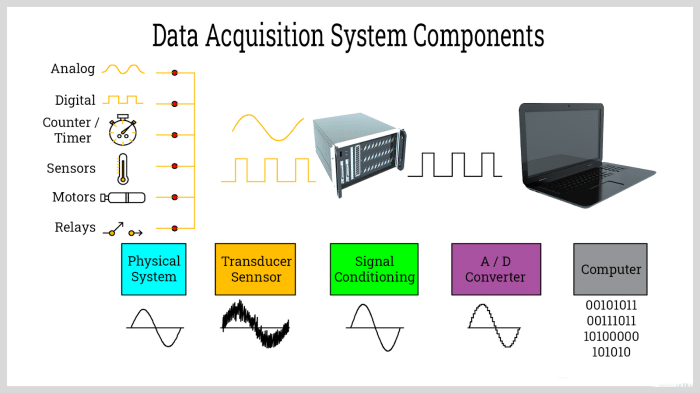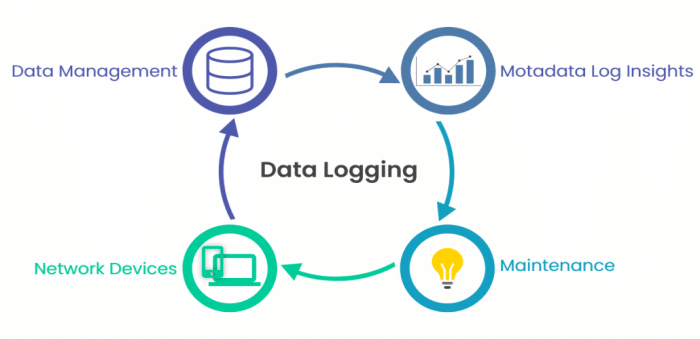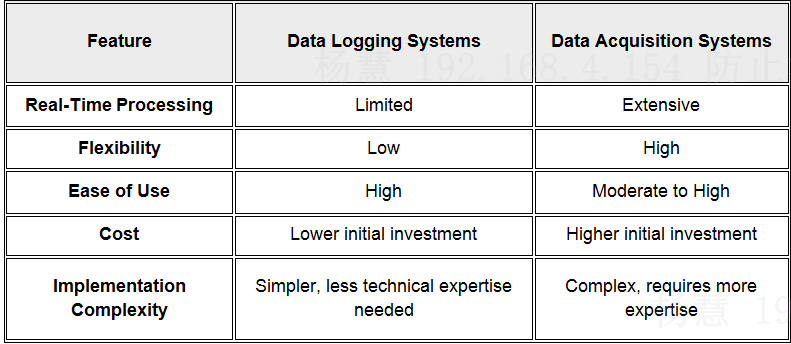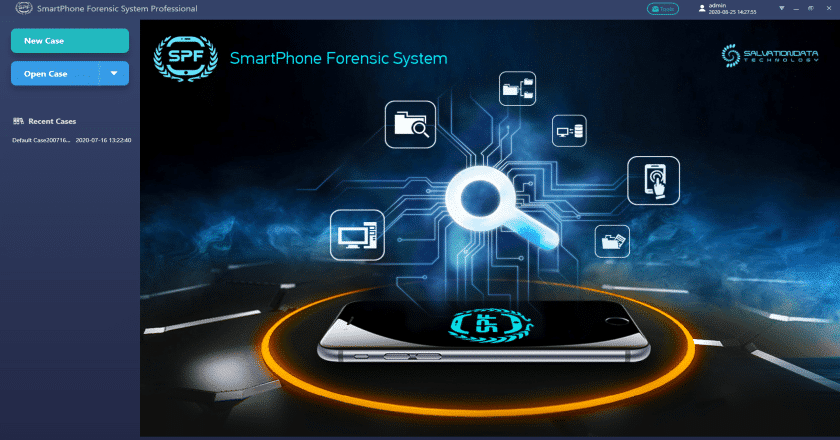Data acquisition and data logging are essential in data management, each with distinct roles. Data acquisition (DAQ) systems enable real-time monitoring for immediate analysis, while data logging records information over time for later review. Understanding the difference is crucial in fields like manufacturing, research, and IoT, where both speed and accuracy impact outcomes. DAQ systems are vital for real-time control and monitoring, while data loggers provide valuable insights through historical data, supporting long-term planning and improvements.
Exploring Differences: Data Acquisition vs. Data Logging

-
Content
- What is Data Acquisition?
- What is Data Logging?
- Key Differences between Data Acquisition and Data Logging
- Pros and Cons of Data Acquisition Systems vs. Data Logging Systems
- Choosing Between Data Acquisition and Data Logging
- Conclusion
-
Content
- What is Data Acquisition?
- What is Data Logging?
- Key Differences between Data Acquisition and Data Logging
- Pros and Cons of Data Acquisition Systems vs. Data Logging Systems
- Choosing Between Data Acquisition and Data Logging
- Conclusion
What is Data Acquisition?
1. Defining Data Acquisition
Data collection involves taking samples of data that measure physical situations in the real world and turning them into digital numbers that a computer can work with. A lot of current tracking and control systems are built around this important technology.
2. Key Components of Data Acquisition
Systems Sensors, data acquisition devices, and software are the three most important parts of any data collection system. Sensors take in real information, like sound, temperature, or pressure, and turn it into electrical messages. The signals are then turned into computer data by data acquisition machines, which are also called data acquisition tools. The software part is meant to understand and examine the data that has been received, which turns it from raw data into useful information.
3. Applications Across Various Fields
A lot of different situations need data gathering. These tools are used in research labs to get accurate results from experiments. In industrial settings, these kinds of systems keep an eye on production lines and tools to make sure they work safely and efficiently. Real-time systems in fields like defense and military also need strong data gathering for real-time analytics, which makes it essential for quick operations.
What is Data Logging?
1. Understanding Data Logging
To log data over time or in relation to a place, you can use a local instrument or sensor, or you can use a computer system to connect instruments and sensors. Data loggers usually work on their own and have sensors, microprocessors, and storage for data inside. They run on batteries.
2. Core Components of Data Logging Systems
Data logs are the machines that gather and store data, so they are an important part of any data logging system. These are backed up by different storage devices that keep the data safe until it’s time to analyze it. Basic software is very important because it makes setting up, collecting, and then analyzing the data that the logs record easier.
3. Applications of Data Logging
Data logging tools are useful in a lot of different areas. These tools are used by environmental tracking systems to keep track of how the weather changes over time. In transportation, data loggers keep an eye on the health of vehicles and fleets to make sure that repair plans and efficiency are optimized.
Key Differences between Data Acquisition and Data Logging
1. Purpose and Functionality
- Data acquisition systems are designed for real-time data analysis, processing, and control.
- Conversely, data logging primarily focuses on storing data for future analysis, making it invaluable in scenarios where the timing of data review is not immediate.
2. Hardware and Software Requirements
- Data acquisition systems often require more complex hardware and sophisticated data acquisition software to handle real-time processing and control.
- This contrasts with data logging systems, which may use simpler, less expensive hardware and software since the data processing demands are generally lower and not performed in real time.
3. Data Processing and Analysis Capabilities
- Data Acquisitionlets you keep an eye on things in real time and act right away based on the data you get.
- In contrast, data logging lets you analyze data after the fact, so you can handle it after the fact without having to move right away.
4. Flexibility and Scalability
- To quickly handle different types of data sources and processing needs, data acquisitionsystems need to be very flexible and scalable.
- Even though data logs can be expanded, they are usually less adaptable because they are made to collect specific data over long periods of time.
5. Cost and Implementation Time
- Data acquisitionsystems usually cost more and take longer to set up because they are more complicated and need to be able to handle data more quickly.
- It is usually easier and cheaper to use a data logging system, which makes it a good choice for projects with limited funds or where speed is not as important.
Pros and Cons of Data Acquisition Systems vs. Data Logging Systems
1. Data Acquisition Systems
PROS
- People really like data gathering systems because they can handle data in real time, giving users quick views that are important for making quick decisions.
- Another big benefit is that these systems are very flexible and can work well with many other technologies and platforms, making the whole system more useful.
- This connection works with a lot of different programs, from simple science study to complicated industry processes.
CONS
- The cost associated with data acquisition can be substantial, particularly as system complexity increases.
- This complexity also contributes to the implementation challenges, as setting up a robust data acquisition systemrequires significant expertise and can be time-intensive.
2. Data Logging Systems
PROS
- People like data logging systems because they are simple, which makes them easy to get and use for many different tasks.
- Another big benefit is that these systems are very cost-effective because they don’t need as much money to be put into them as more complicated data gathering systems do.
- These systems are also very easy to use, so people who aren’t very good at technology can still successfully watch and record data, which is very important in places like basic factory processes or environmental monitoring.
CONS
- One big problem is that they can’t do much work in real time.
- Data loggers usually store data for later use, which can slow down the decision-making process.
- This is different from data collection tools, which can analyze data right away.
- Also, these systems aren’t as adaptable when it comes to adding new technologies or changing to meet new or changing needs, which could mean that more money needs to be spent on systems that are more adaptable.
Choosing Between Data Acquisition and Data Logging
There are a few important things you should think about when choosing between data collection and data logging tools to make sure you get the best technology for your needs.
1. Factors to Consider
- Project Requirements: Which of these two methods to use depends a lot on the type of job. Data capture systems are necessary for projects that need to analyze data in real time and take action right away, like tracking important infrastructure or automating industrial processes. On the other hand, data logging is not needed for projects where the data can be looked at only every so often, like nature studies or long-term market research.
- Budget: Budget limits are also very important when making decisions. Data logging systems are usually less expensive and easier to set up, which makes them good for projects that don’t have a lot of money. Data gathering tools are more expensive, but they offer more features and the ability to work in real time, which may make the extra cost worth it.
- Data Complexity: The pick is also based on how complicated the info is. The strong features of data gathering systems will help with complex data that needs a lot of processing and integrating with other systems.
- Research and Development: In R&D, where data integrity and detailed analysis are critical, choosing a data acquisition system might provide the necessary depth and immediacy of data analysis.
2. An Integrated Forensic Solution Provider-SalvationDATA
- SalvationDATA‘s forensic tools, such as DVR Examiner, VIP 2.0, and SPF Pro, exemplify the cutting-edge capabilities in data acquisition.
- These tools are essential for digital forensicsprofessionals who need to perform data extraction and data recovery from various types of storage media.
- By acquiring, analyzing, and preserving digital evidence in a forensically sound manner, these systems provide invaluable support in forensic investigations, ensuring data integrity and reliability.
- The inclusion of forensic data analysis capabilities further enhances the utility of these tools, making them a staple in modern forensic practices.
Whether you need a system for data collection or data logging, the right one for the job will rely on how much it costs, how complicated it is, and how quickly you need to handle the data. With careful consideration of these factors, businesses can improve their processes and make sure they have the right tools for managing their data.
Conclusion
Ultimately, picking between data acquisition and data logging tools depends on how well you understand their different roles and the needs of your project. The choice should be based on the goals of the project, the budget, and how complicated the data is. Organizations can use the right technology to improve speed, help with decision-making, and drive ideas that meet their business needs if they think about these things. Professionals should be able to use the information in this piece to make smart choices about data management systems and pick the best tool for their needs.





